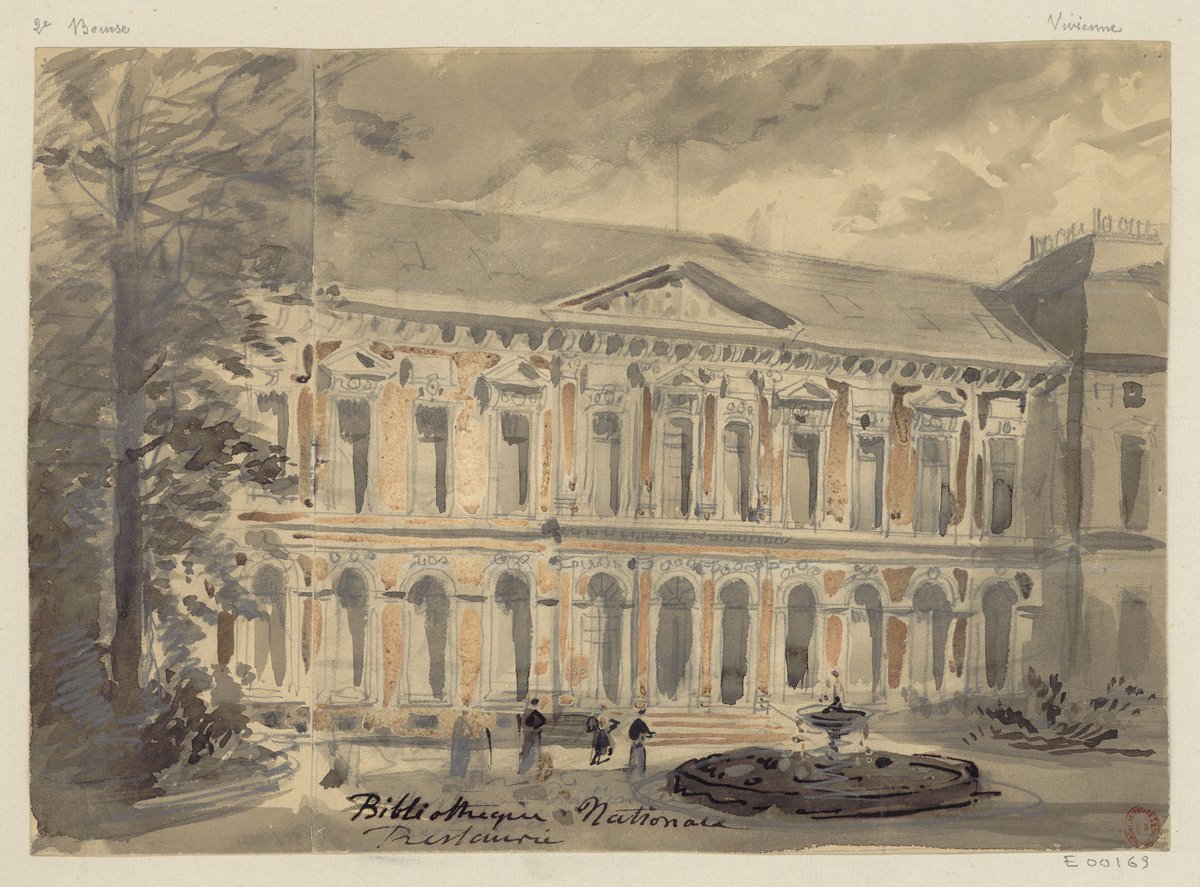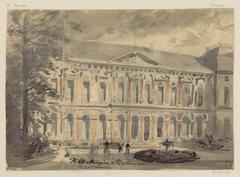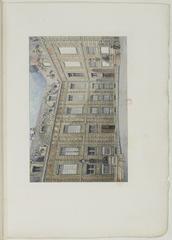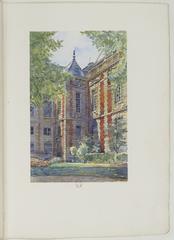
Hôtel Tubeuf Paris: Visiting Hours, Tickets, and Historical Significance Guide
Date: 14/06/2025
Introduction
Hôtel Tubeuf, located in Paris’s 2nd arrondissement, stands as a remarkable example of 17th-century French aristocratic architecture and a living testament to the city’s layered history. Once a private residence for Charles Duret de Chevry, later expanded under Cardinal Mazarin and architect François Mansart, the site is now an integral part of the Bibliothèque nationale de France (BnF) Richelieu complex. This guide offers a detailed overview of Hôtel Tubeuf’s history, visitor information, nearby attractions, accessibility, and practical advice to help you make the most of your visit (Bibliothèque nationale de France, Wikiwand).
Table of Contents
- Introduction
- What is Hôtel Tubeuf?
- Visiting Hôtel Tubeuf: Practical Information
- A Brief Historical Overview
- Notable Features to Explore
- Architectural Context and Urban Setting
- Historical Architectural Evolution
- Architectural Highlights
- Notable Architectural Details
- Preservation and Restoration
- Facilities and Amenities
- Nearby Attractions
- Frequently Asked Questions (FAQ)
- Essential Tips for Visitors
- Visuals and Media Recommendations
- Sustainability and Responsible Tourism
- Conclusion and Final Tips
- References
What is Hôtel Tubeuf?
Hôtel Tubeuf is a classic Parisian hôtel particulier—a grand private mansion—located at 8 rue des Petits-Champs and 16, 16 bis rue Vivienne. Built from 1635 for Charles Duret de Chevry, it epitomizes the brick-and-stone style of early 17th-century France. Over time, the mansion transitioned from a noble residence to a political and commercial power center, and today it forms part of the BnF Richelieu site, housing significant cultural and historical collections (France Hotel Guide).
Visiting Hôtel Tubeuf: Practical Information
Opening Hours
- Days Open: Hôtel Tubeuf is accessible as part of the BnF Richelieu site.
- Hours: Tuesday to Sunday, 10:00 AM – 6:00 PM. Closed Mondays and select holidays.
- Last Entry: 30 minutes before closing.
Note: Always check the official BnF Richelieu website for the most up-to-date hours.
Tickets and Admission
- General Admission: Free access to public areas, including the Hôtel Tubeuf and the Department of Prints and Photography.
- Exhibitions & Guided Tours: Some exhibitions and tours require advance booking and tickets.
Accessibility
- Wheelchair accessible entrances, elevators, and restrooms are available throughout the Richelieu site.
- Staff assistance is available upon request.
(STIRworld)
Getting There
- Metro: Palais Royal – Musée du Louvre (Lines 1, 7), Bourse (Line 3), Richelieu-Drouot (Lines 8, 9)
- Bus: Lines 20, 21, 29, 39, 48, 74, 85
- Bicycle: Vélib’ stations nearby
(Paris Tourist Information)
Visitor Tips
- Arrive on weekday mornings or during off-peak seasons for a quieter experience.
- Photography is permitted in public areas, but flash and tripods are generally prohibited.
- Combine your visit with nearby attractions like Palais Royal, Galerie Vivienne, and the Louvre.
- Respect the heritage site by following posted rules and guidelines.
A Brief Historical Overview
Origins and Early Construction
Commissioned in 1635 by Charles Duret de Chevry and designed by Jean Thiriot, Hôtel Tubeuf was completed after Duret’s death by financier Jacques Tubeuf. The building’s brick-and-stone style, though conservative for its time, is a hallmark of early Parisian aristocratic residences (Wikiwand).
Expansion and Historical Events
- Cardinal Mazarin (1643): Rented and expanded the property, commissioning François Mansart to add the renowned Galerie Mansart and Galerie Mazarin. These galleries became central to Parisian political and cultural life.
- John Law and the Compagnie des Indes (1720): Hôtel Tubeuf served as headquarters for France’s pivotal financial institutions, playing a role in early stock exchange activities.
- Louisiana Purchase Treaty (1803): The treaty that transferred a vast North American territory to the United States was signed in Hôtel Tubeuf, cementing its international significance.
- Integration with the National Library (1826): The mansion became part of the BnF, housing important collections such as the Cabinet des Médailles, and underwent significant restoration in the 21st century (Paris Plus Plus).
Notable Features to Explore
- Galerie Mansart and Galerie Mazarin: Highlights of Baroque elegance resulting from Mazarin’s expansion.
- Grand Staircase: A masterpiece of 17th-century craftsmanship, protected as a Monument Historique.
- Courtyard and Garden: Traditional Parisian layouts offering tranquility in the city center.
Architectural Context and Urban Setting
Located in the historic core of Paris, Hôtel Tubeuf is surrounded by other elegant hôtels particuliers and cultural landmarks. Its proximity to the Palais Royal, Paris Bourse, and the Grands Boulevards situates it at the intersection of history, culture, and commerce (France Hotel Guide).
Historical Architectural Evolution
- Original Construction (1635–1640): Designed by Jean Thiriot for Charles Duret de Chevry.
- Later Modifications: Expanded by Jacques Tubeuf, then by Cardinal Mazarin and architect François Mansart.
- Institutional Integration: Became part of the BnF complex in the 19th century and has been preserved through recent restoration efforts (STIRworld).
Architectural Highlights
- Façade: Dressed limestone, rusticated ground floor, and classic French Baroque symmetry.
- Courtyard and Garden: Traditional cour d’honneur with garden, framed by service wings.
- Interior: Surviving 17th-century wood paneling, marble fireplaces, and ornate plasterwork.
Notable Architectural Details
- Decorative ironwork on gates and balconies.
- Stone carvings and pediments with classical motifs.
- Distinctive roofline and tall chimneys.
Preservation and Restoration
Hôtel Tubeuf is classified as a Monument Historique, ensuring the preservation of its facades, staircase, courtyard, and garden. Restoration projects have focused on maintaining historical integrity while adapting the site for public and institutional use (France Hotel Guide).
Facilities and Amenities
- Cloakroom: Available near the main entrance; large luggage not permitted.
- Restrooms: Accessible and well distributed across the site.
- Refreshments: BnF café and many nearby dining options.
- Wi-Fi: Free throughout the Richelieu Quadrangle.
- Visitor Services: Multilingual staff and digital concierge services (Lonely Planet).
Nearby Attractions
- Palais Royal and Gardens
- Galerie Vivienne
- Paris Bourse
- Grands Boulevards
- Louvre Museum
(France Hotel Guide)
Frequently Asked Questions (FAQ)
Is Hôtel Tubeuf open to the public?
Yes, as part of the BnF Richelieu site, with regular and special event access.
Are guided tours available?
Yes, during special openings or by arrangement via the BnF.
Is there an admission fee?
General access is free; certain exhibitions and tours may require tickets.
Is the site wheelchair accessible?
Yes, with elevators and ramps throughout.
Can I take photos?
Photography is usually permitted in public areas; flash and tripods are restricted.
Essential Tips for Visitors
- Book tickets and tours in advance to avoid disappointment (Salut from Paris).
- Visit during shoulder seasons (spring and autumn) or weekday mornings for fewer crowds (SoloSophie).
- Dress appropriately and respect heritage policies.
- Check the BnF website for up-to-date information on hours, tickets, and events.
Visuals and Media Recommendations
- View high-quality images of Hôtel Tubeuf’s façade, grand staircase, and galleries on the official BnF site.
- Explore interactive maps and virtual tours where available.
Sustainability and Responsible Tourism
Recent restoration emphasized sustainability through energy-efficient systems and careful heritage preservation. Visitors are encouraged to respect the site, minimize waste, and avoid touching artworks or historic surfaces (STIRworld).
Conclusion and Final Tips
Hôtel Tubeuf offers a profound journey through Parisian history, architecture, and culture. As part of the BnF Richelieu site, it’s accessible, well-preserved, and enriched by nearby historical and cultural attractions. For the best experience, plan ahead, respect the heritage environment, and immerse yourself in the rich legacy of this Parisian gem.
Summary: Hôtel Tubeuf stands at the crossroads of Paris’s architectural elegance, political history, and cultural heritage. Its integration into the BnF Richelieu complex ensures public access to its unique features, from ornate galleries to the grand staircase, while its history connects visitors to pivotal moments in French and international affairs. Combine your visit with nearby sites, follow practical tips for accessibility and comfort, and always consult the official BnF resources for the latest visitor information (BnF Richelieu Site, Paris Plus Plus).
For additional guidance and personalized itineraries, download the Audiala mobile app. Stay updated by following the Bibliothèque nationale de France and Audiala on social media.
References and Further Reading
- Bibliothèque nationale de France
- France Hotel Guide
- Wikiwand
- STIRworld
- Paris Plus Plus
- SoloSophie
- Salut from Paris
- Lonely Planet







































































































































































































































